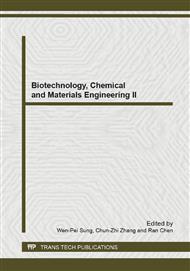[1]
IPCC 2007, Intergovernmental Panel on Climate Change WGI, Fourth Assessment Report, Climate Change 2007: The Physical Science Basis. S. Solomon, D. Qin, M. Manning, Z. Chen, M. Marquis, K.B. Averyt, M. Tignor and H.L. Miller (eds. ), Cambridge University Press, Cambridge, United Kingdom and New York, NY, USA.
DOI: 10.1080/01944363.2014.954464
Google Scholar
[2]
FAO, World agriculture: towards 2015, 2030, An FAO perspective, FAO, Rome, (2003).
DOI: 10.1016/s0264-8377(03)00047-4
Google Scholar
[3]
X.L. Li, W. P. Yuan, H. Xu, Z.C. Cai, K. Yagi, Effect of timing and duration of midseason aeration on CH4 and N2O emissions from irrigated lowland rice paddies in China, Nutrient Cycling in Agroecosystems. 91 (2011) 293-305.
DOI: 10.1007/s10705-011-9462-0
Google Scholar
[4]
S. Frolking, J.J. Qiu, S. Boles, X.M. Xiao, J.Y. Liu, Y.H. Zhuang, C.S. Li, X.G. Qin, Combing remote sensing and ground census data to develop new maps of the distribution of rice agriculture in China, Global Biogeochem Cycles. 16 (2002).
DOI: 10.1029/2001gb001425
Google Scholar
[5]
Y.S. Wang, Y.H. Wang, Quick measurement of CH4, CO2 and N2O emissions from a short-plant ecosystem, Advances in atmospheric sciences. 20 ( 2003) 842-844.
DOI: 10.1007/bf02915410
Google Scholar
[6]
X.H. Zheng, M.X. Wang, Y.S. Wang, Temperature effect on N2O produce and emission from agricultural field. Environmental Science 18 (1997) 1-5.
Google Scholar
[7]
X.H. Zheng, M.X. Wang, Y. Wang, R. Shen, X. Shangguan, J. Heyer, M. Kögge, H. Papen, J. Jin, L. Li, CH4 and N2O emissions from rice paddies in southeast China, Chinese Journal of Atmosphere Science. 21 (1997) 167-174.
Google Scholar
[8]
J.W. Zou, Y. Huang, Y.M. Qing, S.W. Liu, Q.R. Shen, G.X. Pan, Y.Y. Lu, Q.H. Liu, Changes in fertilizer-induced direct N2O emissions from paddy fields during rice-growing season in China between 1950s and 1990s, Global Change Biology. 15 (2009).
DOI: 10.1111/j.1365-2486.2008.01775.x
Google Scholar
[9]
K.A. Smith, T. Ball, F. Conen, K.E. Dobbie, J. Massheder, A. Rey, Exchange of greenhouse gases between soil and atmosphere: interactions of soil physical factors and biological processes, European Journal of Soil Science. 54 ( 2003) 779-791.
DOI: 10.1046/j.1351-0754.2003.0567.x
Google Scholar
[10]
C. Kreye, K. Dittert, X.H. Zheng, X. Zhang, S. Lin, H.B. Tao, B. Sattelmacher, Fluxes of methane and nitrous oxide in water-saving rice production in north China, Nutrient Cycling in Agroecosystems. 7 (2007) 293-304.
DOI: 10.1007/s10705-006-9068-0
Google Scholar
[11]
C.F. Li, C.G. Cao, J.P. Wang, M. Zhan, W.L. Yuan, Nitrous oxide emissions from wetland rice–duck cultivation systems in Southern China, Arch Environ Contam Toxicol. 56 (2009) 21-29.
DOI: 10.1007/s00244-008-9159-9
Google Scholar
[12]
C.C. Chao, C.C. Young, Y.P. Wang, W.L. Chao, Daily and seasonal nitrous oxide fluxes in soils from hardwood forest and different agroecosystems of Taiwan, Chemosphere. 2 (2000) 77-84.
DOI: 10.1016/s1465-9972(99)00047-1
Google Scholar
[13]
C. Müller, R.R. Sherlock, Nitrous oxide emissions from temperate grassland ecosystems in the Northern and Southern Hemispheres. Global Biogeochemical Cycles. 18 (2004) GB1045.
DOI: 10.1029/2003gb002175
Google Scholar
[14]
K.K. Baruah, B. Gogoi, P. Gogoi, Plant physiological and soil characteristics associated with methane and nitrous oxide emission from rice paddy, Physiol. Mol. Biol. Plants. 16 (20101) 79-91.
DOI: 10.1007/s12298-010-0010-1
Google Scholar
[15]
K.W. Yu, Z.P. Wang, G.X. Chen, Nitrous oxide and methane transport through rice plants, Biology and Fertility of Soils. 24 (1997) 341-343.
DOI: 10.1007/s003740050254
Google Scholar
[16]
X. Yan, S. Shi, L. Du, Pathways of N2O emission from rice paddy soil, Soil Biology & Biochemistry. 32 (2000) 437-440.
DOI: 10.1016/s0038-0717(99)00175-3
Google Scholar
[17]
S.H. Huang, J. Lu, G.M. Tian, Effects of cracks and some key factors on emissions of nitrous oxide in paddy fields, Journal of Evironmental Sciences. 17 (2005) 37-42.
Google Scholar
[18]
S.H. Huang, J. Lu, G.H. Zeng, The influences of generation of paddy soil cracks on N2O emissions, China Environmental Science. 24 (2004) 410-413.
Google Scholar


